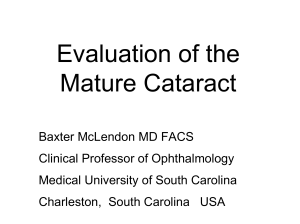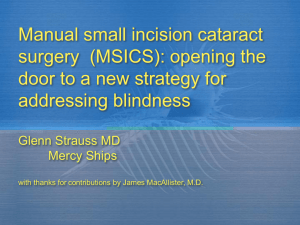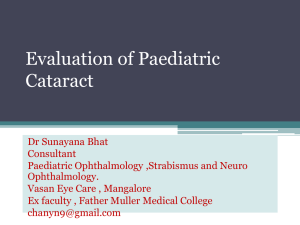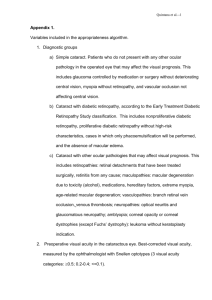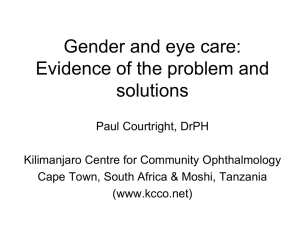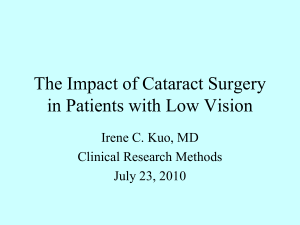Cataract
advertisement
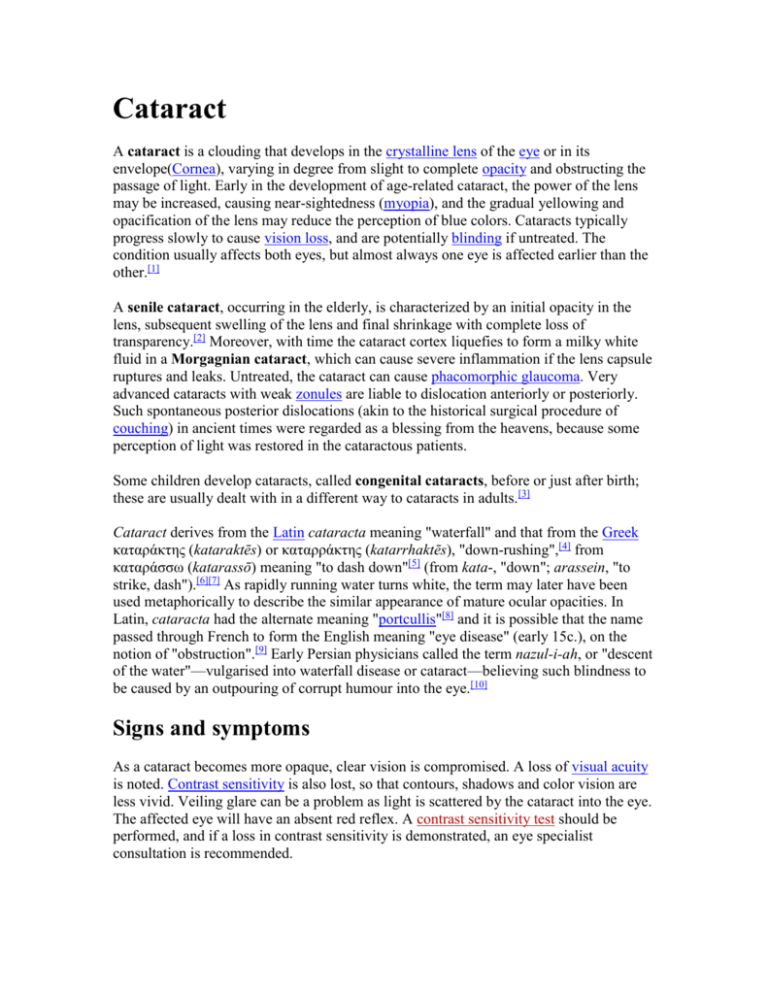
Cataract A cataract is a clouding that develops in the crystalline lens of the eye or in its envelope(Cornea), varying in degree from slight to complete opacity and obstructing the passage of light. Early in the development of age-related cataract, the power of the lens may be increased, causing near-sightedness (myopia), and the gradual yellowing and opacification of the lens may reduce the perception of blue colors. Cataracts typically progress slowly to cause vision loss, and are potentially blinding if untreated. The condition usually affects both eyes, but almost always one eye is affected earlier than the other.[1] A senile cataract, occurring in the elderly, is characterized by an initial opacity in the lens, subsequent swelling of the lens and final shrinkage with complete loss of transparency.[2] Moreover, with time the cataract cortex liquefies to form a milky white fluid in a Morgagnian cataract, which can cause severe inflammation if the lens capsule ruptures and leaks. Untreated, the cataract can cause phacomorphic glaucoma. Very advanced cataracts with weak zonules are liable to dislocation anteriorly or posteriorly. Such spontaneous posterior dislocations (akin to the historical surgical procedure of couching) in ancient times were regarded as a blessing from the heavens, because some perception of light was restored in the cataractous patients. Some children develop cataracts, called congenital cataracts, before or just after birth; these are usually dealt with in a different way to cataracts in adults.[3] Cataract derives from the Latin cataracta meaning "waterfall" and that from the Greek καταράκτης (kataraktēs) or καταρράκτης (katarrhaktēs), "down-rushing",[4] from καταράσσω (katarassō) meaning "to dash down"[5] (from kata-, "down"; arassein, "to strike, dash").[6][7] As rapidly running water turns white, the term may later have been used metaphorically to describe the similar appearance of mature ocular opacities. In Latin, cataracta had the alternate meaning "portcullis"[8] and it is possible that the name passed through French to form the English meaning "eye disease" (early 15c.), on the notion of "obstruction".[9] Early Persian physicians called the term nazul-i-ah, or "descent of the water"—vulgarised into waterfall disease or cataract—believing such blindness to be caused by an outpouring of corrupt humour into the eye.[10] Signs and symptoms As a cataract becomes more opaque, clear vision is compromised. A loss of visual acuity is noted. Contrast sensitivity is also lost, so that contours, shadows and color vision are less vivid. Veiling glare can be a problem as light is scattered by the cataract into the eye. The affected eye will have an absent red reflex. A contrast sensitivity test should be performed, and if a loss in contrast sensitivity is demonstrated, an eye specialist consultation is recommended. It may be advisable to seek medical opinion, particularly in high-risk groups such as diabetics, if a "halo" is observed around street lights at night, especially if this phenomenon appears to be confined to one eye only. The symptoms of cataracts are very similar to the symptoms of ocular citrosis. Causes Several factors can promote the formation of cataracts, including long-term exposure to ultraviolet light, exposure to ionising radiation, secondary effects of diseases such as diabetes, hypertension and advanced age, or trauma (possibly much earlier); they are usually a result of denaturation of lens protein. Genetic factors are often a cause of congenital cataracts, and positive family history may also play a role in predisposing someone to cataracts at an earlier age, a phenomenon of "anticipation" in presenile cataracts. Cataracts may also be produced by eye injury or physical trauma. A study among Icelandair pilots showed commercial airline pilots are three times more likely to develop cataracts than people with nonflying jobs. This is thought to be caused by excessive exposure at high altitudes to radiation coming from outer space which becomes attenuated by atmospheric absorption at ground level.[11] Supporting this theory is the report that 33 of the 36 Apollo astronauts involved in the nine Apollo missions to leave Earth orbit have developed early stage cataracts that have been shown to be caused by exposure to cosmic rays during their trip.[12] At least 39 former astronauts have developed cataracts, of whom 36 were involved in high-radiation missions such as the Apollo missions.[13] Cataracts are also unusually common in persons exposed to infrared radiation, such as glassblowers, who suffer from "exfoliation syndrome". Exposure to microwave radiation can cause cataracts. Atopic or allergic conditions are also known to quicken the progression of cataracts, especially in children.[14] Cataracts can also be caused by iodine deficiency.[15] Cataracts may be partial or complete, stationary or progressive, hard or soft. Some drugs can induce cataract development, such as corticosteroids[16] and the antipsychotic drug quetiapine (sold as Seroquel, Ketipinor, Quepin). There are various types of cataracts, e.g. nuclear, cortical, mature, and hypermature. Cataracts are also classified by their location, e.g. posterior (classically due to steroid use)[16][17] and anterior (common (senile) cataract related to aging). Classification Bilateral cataracts in an infant due to congenital rubella syndrome The following is a classification of the various types of cataracts. This is not comprehensive, and other unusual types may be noted. Classified by etiology Age-related cataract Cortical senile cataract Immature senile cataract (IMSC): partially opaque lens, disc view[clarification needed] hazy Mature senile cataract (MSC): completely opaque lens, no disc view Hypermature senile cataract (HMSC): liquefied cortical matter: Morgagnian cataract Cataracta brunescens Cataracta nigra Cataracta rubra Senile nuclear cataract Congenital cataract Sutural cataract Lamellar cataract Zonular cataract Total cataract Secondary cataract Slit lamp photo of anterior capsular opacification visible a few months after implantation of intraocular lens in eye, magnified view Drug-induced cataract (e.g. corticosteroids) Traumatic cataract Blunt trauma (capsule usually intact) Penetrating trauma (capsular rupture and leakage of lens material—calls for an emergency surgery for extraction of lens and leaked material to minimize further damage) Classified by opacities, cataract can be classified by using Lens Opacities Classification System III (LOCS III: Nuclear NC1-5, Cortical C1-5 and Posterior P1-5. By application planning in procedures of phacoemulsification, LCOS III can be converted in newer cataract grading systems. Gede Pardianto (2009) introduced Optical Biometry Based Cataract Grading System (OBBCGS) that is helpful in cataract grading due to phacoemulsification planning. LOCS III's NC0, C0 and P0 can be converted as OBBCGS' no cataract (NC), LOCS III's NC1-3, C1-3, P1-4 can be converted to OBBCGS' Optical Biometry Examined Cataract (OBEC) and LOCS III's NC4-5, C4-5, P4-5 can be converted to OBBCGS's Optical Biometry Unexamined Cataract (OBUC); that need examination by Applanation Ultrasound Biometry.[19] Classified by location of opacity within lens structure (however, mixed morphology is quite commonly seen, e.g. PSC with nuclear changes and cortical spokes of cataract) Anterior cortical cataract Anterior polar cataract Anterior subcapsular cataract Slit lamp photo of posterior capsular opacification visible a few months after implantation of intraocular lens in eye, seen on retroillumination Nuclear cataract—grading correlates with hardness and difficulty of surgical removal 1: Grey 2: Yellow 3: Amber 4: Brown/black (Note: "black cataract" translated in some languages (like Hindi) refers to glaucoma, not the color of the lens nucleus) Posterior cortical cataract Posterior polar cataract (importance lies in higher risk of complication— posterior capsular tears during surgery) Posterior subcapsular cataract (PSC) (clinically common) After-cataract: posterior capsular opacification (PCO) subsequent to a successful extracapsular cataract surgery (usually within three months to two years) with or without IOL implantation. Requires a quick and painless office procedure with Nd:YAG laser capsulotomy to restore optical clarity. Prevention Although cataracts have no scientifically proven prevention, wearing ultraviolet-protecting sunglasses may slow the development of cataracts.[20][21] It has been suggested that regular intake of antioxidants (such as vitamins A, C and E) is helpful, but taking them as a supplement has not been shown to have a benefit.[22] Although statins are known for their ability to lower lipids, they are also believed to have antioxidant qualities. Oxidative stress is believed to play a role in the development of nuclear cataracts, which are the most common type of age-related cataracts. To explore the relationship between nuclear cataracts and statin use, a group of researchers treated a group of 1299 patients who were at risk of developing nuclear cataracts with statins. Their results suggest statin use in an at-risk population may be associated with a lower risk of developing nuclear cataract disease.[23][better source needed] Treatment Non-surgical Topical treatment (eye drops) with the less wellknown antioxidant N-acetylcarnosine has been shown in randomized controlled clinical trials to improve transmissivity and reduce glare sensitivity for patients with cataracts.[24] After animal experiments researchers of a pharmaceutical company have proposed Nacetylcarnosine as a treatment for ocular disorders that have a component of oxidative stress in their genesis, including cataracts, glaucoma, retinal degeneration, corneal disorders, and ocular inflammation.[25] Long term (average five year) observation showed systematic application of azapentacene sodium polysulfonate (Quinax) slows down the progress of the disease.[26] Research Research is scant and mixed, but weakly positive, for the nutrients lutein and zeaxanthin.[27][28][29][30] Bilberry extract shows promise in rat models[31][32] and in clinical studies.[33] In the early twentyfirst century eye drops containing acetyl-carnosine have been used by several thousands of cataract patients across the world. The drops are believed to work by reducing oxidation and glycation damage in the lens, particularly reducing crystallin crosslinking.[34][35] Randomized controlled trials indicate the drops may be especially appropriate for seniors, or others where surgery is not advised.[36] Surgical Main article: Cataract surgery Cataract surgery, using a temporal approach phacoemulsification probe (in right hand) and "chopper" (in left hand) being done under operating microscope at a Navy medical center The operation to remove cataracts can be performed at any stage of their development. There is no longer a reason to wait until a cataract is "ripe" before removing it.[37] However, because all surgery involves some risk, it is usually worth waiting until there is some change in vision before removing the cataract.[37] The most effective and common treatment is to make an incision (capsulotomy) into the capsule of the cloudy lens to surgically remove it. Two types of eye surgery can be used to remove cataracts: extracapsular cataract extraction (ECCE) and intracapsular cataract extraction (ICCE). ECCE surgery consists of removing the lens, but leaving the majority of the lens capsule intact. High frequency sound waves (phacoemulsification) are sometimes used to break up the lens before extraction. Intra-capsular (ICCE) surgery involves removing the lens and lens capsule, but it is rarely performed in modern practice. In either extracapsular surgery or intracapsular surgery, the cataractous lens is removed and replaced with a plastic lens (an intraocular lens implant) which stays in the eye permanently. Cataract operations are usually performed using a local anaesthetic, and the patient is allowed to go home the same day. Until the early twentyfirst century intraocular lenses were always monofocal; since then improvements in intraocular technology allow implanting a multifocal lens to create a visual environment in which patients are less dependent on glasses. Such multifocal lenses are mechanically flexible and can be controlled using the eye muscles used to control the natural lens. Complications are possible after cataract surgery, including endophthalmitis, posterior capsular opacification and retinal detachment. Laser surgery involves cutting away a small circle-shaped area of the lens capsule, enough to allow light to pass directly through the eye to the retina. There are, as always, some risks, but serious side effects are very rare.[38] As of 2012 research into the use of extremely-short-pulse (femtosecond) lasers for cataract surgery was being carried out[39]. High frequency ultrasound is also used for cataract surgery[40]. Epidemiology Disability-adjusted life year for cataracts per 100,000 inhabitants in 2004.[41] no data less than 90 90-180 180-270 270-360 360-450 450-540 540-630 630-720 720-810 810-900 900-990 more than 990 Age-related cataract is responsible for 48% of world blindness, which represents about 18 million people, according to the World Health Organization (WHO).[42] In many countries, surgical services are inadequate, and cataracts remain the leading cause of blindness. As populations age, the number of people with cataracts is growing. Cataracts are also an important cause of low vision in both developed and developing countries. Even where surgical services are available, low vision associated with cataracts may still be prevalent, as a result of long waits for operations and barriers to surgical uptake, such as cost, lack of information and transportation problems. In the United States, age-related lenticular changes have been reported in 42% of those between the ages of 52 and 64,[43] 60% of those between the ages 65 and 74,[44] and 91% of those between the ages of 75 and 85.[43] The increase in ultraviolet radiation resulting from depletion of the ozone layer is expected to increase the incidence of cataracts.[45] History The first references to cataract and its treatment in Ancient Rome are found in 29 CE in De Medicinae, the work of the Latin encyclopedist Aulus Cornelius Celsus.[46] The Romans were pioneers in the health arena—particularly in the area of eye care.[47] Other early accounts are those in Sanskrit medical literature. Early cataract surgery was described by the Indian physician, Suśruta (fl. ca. AD 200).[48] For a full citation translated from the original Sanskrit, see the Wikipedia entry on Cataract Surgery. The Muslim ophthalmologist Ammar ibn Ali, in his Choice of Eye Diseases, written circa 1000 CE, wrote of his invention of the hypodermic needle and how he discovered the technique of cataract extraction while experimenting with it on a patient.[49]

